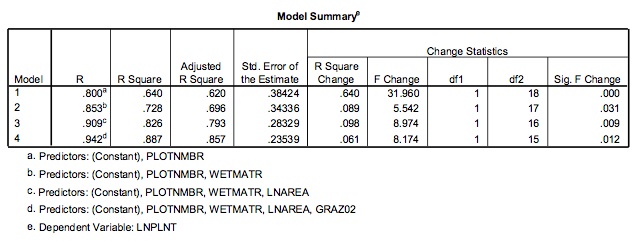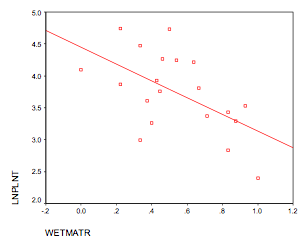Local and Landscape Contributions to Plant Species Richness in Montane Meadows in the Eastern Sierra Nevada of California.

SCOTT SIMONO
Abstract
Meadow habitats comprise less than ten percent of the Sierra Nevada yet are the center of its plant diversity. Understanding the scale at which an element contributes to species richness is an important tool in the effective management and conservation of this resource. We measured plant species richness in 48 meadows. We tested variables at the local and landscape level for their ability to predict variation in plant species richness among meadows using linear regression. Three meadow factors significantly influenced variation but no larger landscape factors predicted variation in plant species richness.
Introduction
All of the plant communities of California have been threatened by human activity and development. Mountain meadows of the Eastern Sierra Nevada have been subjected to grazing, agriculture, logging, road building and are now threatened by development for recreation and housing. Meadow habitats comprise less than ten percent of the Sierra Nevada yet are the center of its plant diversity. In some areas over forty percent of the floral diversity is accounted for by meadows(1). These meadows also supply a disproportionate and vital contribution to ecosystem function through hydrology and wildlife support and have great aesthetic value to humans, especially on the dry eastern slopes of the eastern Sierra Nevada of California. The scale at which meadow and landscape elements contribute to species richness is important in ecology and conservation. Many studies have focused on the effects of local habitat and larger landscape factors on species richness. Landscape factors include elevation, type and condition of surrounding landscape and factors of dispersal such as habitat isolation. Patch factors include habitat patch area, measures of interior to edge habitat and habitat heterogeneity from natural and anthropogenic causes. The importance of considering many scales of influence on the species richness of invertebrate and vertebrate taxa is well demonstrated(2). The evidence for the importance of scale considerations with plant taxa is not yet clear. Studies have drawn contradictory conclusions on the importance of landscape scale factors on plant diversity in a habitat and on what patch attributes to consider when building a model for predicting plant species richness. These studies have dealt mainly with changes in species richness due to anthropogenic changes such as fragmentation rather than assessing the qualities of habitat diversity for conservation and management. We want to determine the factors that contribute to habitat diversity and quality in montane meadows. We are seeking to evaluate local and landscape variables as predictors for plant species richness in montane meadows that will help in the conservation and management of this great resource.
Methods
Study Site:
The study took place during the summer in 2002 and 2003 in 20 meadows in the Tahoe National Forest near Truckee, California in Nevada and Sierra counties.The meadows are part of the drainage basins for Davies Creek, Little Truckee River, Prosser Creek and Sagehen Creek.The meadows ranged in size from3.5 hectare to 75 hectares and in elevation from 1736 to 1885 meters.
Plant Species Richness:
We sampled plant species in each meadow using 1/4m x 20m quadrats. The number of quadrats per meadow was scaled to meadow size and ranged from 1 to 25. Quadrats were located using randomly generated coordinates.All flowering plants excluding gramminoids were identified to species where possible and scored for presence or absence in each meadow.
Independent Variables:
-Local Factors included measures of:
meadow area
area to perimeter ratio
meadow moisture (from 0 to 1; 0=driest, 1=wettest) type of livestock grazing (1=none, 2=cattle, 3=sheep)
-Landscape level variables included measures of:
matrix composition and meadow isolation.
elevation
Data Analysis:
We used the program SPSS 11.5 to build linear regression models using number of plant species per meadow as our dependent variable.Variables were transformed when necessary to meet the assumptions of the statistical test.
Results
Total plant species ranged from 11 to 113 per meadow. No landscape scale factors significantly explained variation in plant species richness in the regression model.Three local habitat level factors proved significant predictors of plant species richness: Meadow wetness, Area, Grazing. R square for the final model was 0.887 with P = 0.012, P<0.05 was significant. Plant Species Richness increased with area (fig.1) and was greater in drier meadows than wet (fig. 2).
Discussion
Our data supports the link between habitat area and species diversity outlined by the theory of island biogeography (3). However, the lack of any significant affect from any larger landscape scale factors suggests that meadow isolation and dispersal between meadows plays a less important role than within meadow effects, suggesting we look in the opposite direction of scale for clues to plant species diversity in montane meadows. We found that grazing and the degree of habitat wetness were factors that could be used in predicting plant species richness, but why? There may be higher species diversity because grazed meadows and drier meadows in combination with larger meadow size contribute to habitat heterogeneity, providing more niches for taxa with different environmental requirements to exploit. Assessment of species richness in homogenous patches has been the subject of many ecological papers, but a method for assessing plant species richness in heterogenous habitats from landscape structure and composition is still not clear(4). We hope that further research will provide us the tools for defining factors of habitat heterogeneity in montane meadows and how they contribute to plant species richness so that they can be used as a tool in conservation of montane meadows in the California Sierra Nevada.
Plant Species Richness increased with area (fig.1) and was greater in drier meadows than wet (fig. 2).


